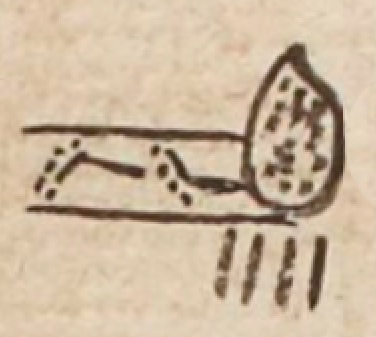Nauhyotl (Verg9v)
This black-line drawing of the compound glyph for the personal name Nauhyotl (“Having the Quality of Four,” attested here as a man’s name) is a cluster of three elements. One element, in the lower right, shows four (nahui) straight lines. Above and to the left of these lines is a bird's eye view of a road (otli) with two alternating footprints (suggesting movement). This road provides the phonetic indicator for the "-yotl" suffix ("having the quality of"). A third element is a rather amorphous shape, almost circular, with many dots inside it. What this element represents has yet to be deciphered.
Stephanie Wood
There was a Nauhyotl Tecuhtli, the Lord of the Four Directions. So, perhaps Nauhyotl and Nauhyotzin were shorter versions of this, or perhaps they also had some connection with cardinal directions.
The seventh ruler of Culhuacan had the name Nauhyotl Tecuhtlamacazqui. The simpler name Nauhyotl is further attested in at least a couple of censuses for various men after colonization. Here, too, the man bearing this name has the baptismal name Juan.
The even numbers four and eight were pervasive in Nahua culture. The suffix "-yotl" is, according to James Lockhart, "an abstract or collective nominal suffix that, when possessed, expresses inalienable or organic possession" (see his Nahuatl as Written: Lessons in Older Written Nahuatl, with Copious Examples and Texts, Stanford: Stanford University Press and UCLA Latin American Studies, 2001, 242). In English, this can be something like the suffix -ness, or -ship, or refer to a design of the type mentioned in the noun. One might think of nauhyotl as referring to a quatrefoil, but the visual is very basic, seeming relating to counting, and nothing like the four-division shield or the shape of the sun. Here, the tlacuilo wished to convey the number and its meaning.
Notice how some tonalli (sun, day, solar energizing force) signs can appear as four circles (below).
Guy Stresser-Péan (1995, 150) suggests "abstracción del número cuatro" as the translation of Nauhyotl. (See our Bibliography for the full citation of his book.) Magnus Pharao Hansen translates Nauhyotl as "Fourth," in his 2014 blog about the 1544 census of Morelos.
Some names that are simply numbers, such as Macuilli, may have originally been names from the divinatory calendars, having had a number from one to thirteen in combination with one of twenty day signs. But, here, the -yotl suffix takes the number name more toward an emphasis on just the number itself and probably its symmetry. Omeyotl is another example, although it is less popular as a personal name than Nauhyotl.
Stephanie Wood
alonso nauhyotl
Alonso Nauhyotl
Stephanie Wood
1539
Jeff Haskett-Wood

Nauhyotl, a name, https://nahuatl.wired-humanities.org/content/nauhyotl
nahui, four, https://nahuatl.wired-humanities.org/content/nahui
o(tli), road, https://nahuatl.wired-humanities.org/content/otli
La Calidad o Naturaleza de Cuatro, Cuatredad
Stephanie Wood
Codex Vergara, folio 9v, https://gallica.bnf.fr/ark:/12148/btv1b84528032/f26.item.zoom
The non-commercial reuse of images from the Bibliothèque nationale de France is free as long as the user is in compliance with the legislation in force and provides the citation: “Source gallica.bnf.fr / Bibliothèque nationale de France” or “Source gallica.bnf.fr / BnF.” We would also appreciate a citation to the Visual Lexicon of Aztec Hieroglyphs, https://aztecglyphs.wired-humanities.org/.








